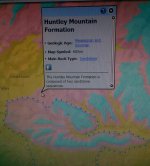k-bob
Well-known member
- Joined
- Jul 29, 2009
- Messages
- 2,373
as discussed before, many PA streams are affected by acid rain, and effects vary with bedrock geology (bedrock types have varying ability to neutralize acid). this state map has nice bedrock geology info, zoom out a bit, geology tab upper right:
http://www.gis.dcnr.state.pa.us/maps/index.html
PA has many types of bedrock. A few are known as lower buffering/ bad for fertility & trout (Tuscarora) or higher buffering/good for fertility & trout (Juniata). (Shawangunk is moderate.) For example, if you look at swift run south of penns creek, noted for bad acid rain effects, it is in a Tuscarora bedrock band. Some nearby streams have different geology and may have more bugs and/or salmonoids.
I came across info on the median pH for water from wells in various bedrock types. This is well water pH and not stream pH, but it may have some utility in finding streams w/ more bugs and trout due to higher-buffering bedrock:
Median pH of water from wells by bedrock, Susquehanna basin:
Burgoon 6.4
Pottsville 6.8
Mauch chunk 6.8
Bald eagle 7.0
Catskill 7.1
Huntley 7.1
Bloomsburg 7.4
Juniata 7.4
anyone know of a complete online set of such info? many bedrock types out there. thanks
http://www.gis.dcnr.state.pa.us/maps/index.html
PA has many types of bedrock. A few are known as lower buffering/ bad for fertility & trout (Tuscarora) or higher buffering/good for fertility & trout (Juniata). (Shawangunk is moderate.) For example, if you look at swift run south of penns creek, noted for bad acid rain effects, it is in a Tuscarora bedrock band. Some nearby streams have different geology and may have more bugs and/or salmonoids.
I came across info on the median pH for water from wells in various bedrock types. This is well water pH and not stream pH, but it may have some utility in finding streams w/ more bugs and trout due to higher-buffering bedrock:
Median pH of water from wells by bedrock, Susquehanna basin:
Burgoon 6.4
Pottsville 6.8
Mauch chunk 6.8
Bald eagle 7.0
Catskill 7.1
Huntley 7.1
Bloomsburg 7.4
Juniata 7.4
anyone know of a complete online set of such info? many bedrock types out there. thanks





